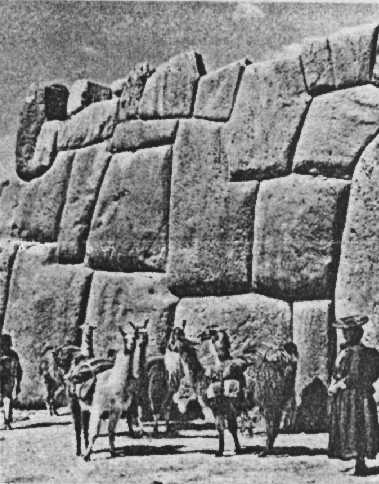 |
Science Frontiers ONLINE No. 44: Mar-Apr 1986 |
|
|
How The Incas Worked Stone
Inca stonework is famous for its large stones (some over 100 tons), which are fitted so precisely that "a knife cannot be inserted into the joints." An aura of mystery has always hung about the great "walls" at Saqsaywaman and Ollantaytambo (spellings vary). How could the Incas have quarried, dressed, transported, and lifted such huge stones? As usual with such remarkable ancient structures, the overzealous have proposed antigravity devices, stone-softening agents, and similar wild notions. In truth, as J. Protzen relates in the subject article, Inca stonemasonry was surprisingly unsophisticated and yet efficient, although some mysteries remain.
Protzen has spent many months in Inca country experimenting with different methods of shaping and fitting the same kinds of stones used by the Incas. He found that quarrying and dressing the stones were not problems at all using the stone hammers found in abundance in the area. Even the precision-fitting of stones was a relatively simple matter. The concave depressions into which new stones were fit were pounded out by trial and error until a snug fit was achieved. Protzen's first-hand experience is impressive and convincing. Certainly he required no radical solutions.
The problems that Protzen was not able to solve to his satisfaction involved the transportation and handling of the large stones. The fitting process necessitated the repeated lowering and raising of the stone being fitted, with trial-and-error pounding in between. He does not know just how 100-ton stones were manipulated during this stage. To transport the stones from the quarries, some as far as 35 kilometers distant, the Incas built special access roads and ramps. Many of the stones were dragged over gravel-covered roads, as evidenced by their polished surfaces. The largest stone at Ollantaytambo weighs about 140,000 kilograms. It could have been pulled up a ramp with a force of about 120,000 kilograms. Such a feat would have required some 2,400 men. Getting the men was no problem, but where did they all stand? The ramps were only 8 meters wide at most. A minor problem perhaps, but still unsolved. Further, the stones used at Saqsaywaman were fine-dressed at the Rumiqolqa quarry and show no signs of dragging. Protzen does not know how they were transported 35 kilometers.
An intriguing observation by Protzen is that the cutting marks on some of the stone blocks are very similar to those found on the pyramidion of the unfinished obelisk from Aswan in Egypt. Is this a case of anomalous diffusion of Old World technology or simply independent invention?
(Protzen, Jean-Pierre; "Inca Stonemasonry," Scientific American, 254:94, February 1986.)
Reference. For more on Inca-built structures, see our Handbook Ancient Man. Ordering information here.
 | Typical, close-fitted, massive irregular stones in an Inca wall. From Ancient Man. |